window Citroen C4 2014 2.G Owner's Manual
[x] Cancel search | Manufacturer: CITROEN, Model Year: 2014, Model line: C4, Model: Citroen C4 2014 2.GPages: 340, PDF Size: 28.99 MB
Page 4 of 340
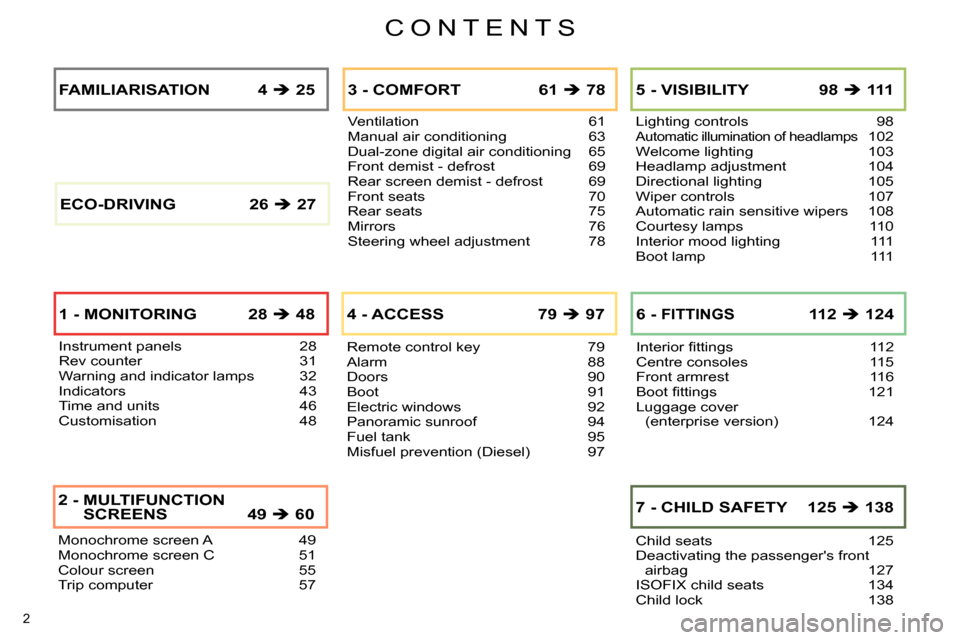
CONTENTS
2
Monochrome screen A 49
Monochrome screen C 51
Colour screen 55
Trip computer 57
2 - MULTIFUNCTION
SCREENS 49 60
Ventilation 61
Manual air conditioning 63
Dual-zone digital air conditioning 65
Front demist - defrost 69
Rear screen demist - defrost 69
Front seats 70
Rear seats 75
Mirrors 76
Steering wheel adjustment 78
3 - COMFORT 61 78
Remote control key 79
Alarm 88
Doors 90
Boot 91
Electric windows 92
Panoramic sunroof 94
Fuel tank 95
Misfuel prevention (Diesel) 97
4 - ACCESS 79 97
Lighting controls 98Automatic illumination of headlamps 102
Welcome lighting 103
Headlamp adjustment 104
Directional lighting 105
Wiper controls 107
Automatic rain sensitive wipers 108
Courtesy lamps 110
Interior mood lighting 111
Boot lamp 111
5 - VISIBILITY 98 111
Interior fi ttings 112
Centre consoles 115
Front armrest 116
Boot fi ttings 121
Luggage cover
(enterprise version) 124
6 - FITTINGS 112 124
Instrument panels 28
Rev counter 31
Warning and indicator lamps 32
Indicators 43
Time and units 46
Customisation 48
FAMILIARISATION 4 25
1 - MONITORING 28 48
Child seats 125
Deactivating the passenger's front
airbag 127
ISOFIX child seats 134
Child lock 138
7 - CHILD SAFETY 125 138 ECO-DRIVING 26 27
Page 8 of 340
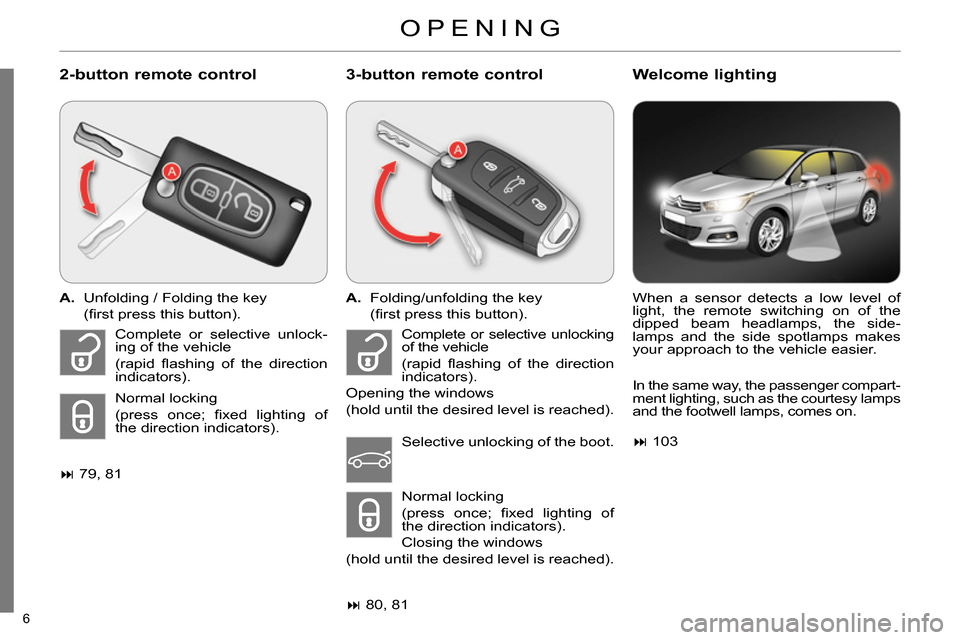
6
OPENING
2-button remote control
3-button remote control
Welcome lighting
A.
Unfolding / Folding the key
(fi rst press this button).
79, 81
A.
Folding/unfolding the key
(fi rst press this button).
80, 81
When a sensor detects a low level of
light, the remote switching on of the
dipped beam headlamps, the side-
lamps and the side spotlamps makes
your approach to the vehicle easier. Complete or selective unlock-
ing of the vehicle
(rapid fl ashing of the direction
indicators).
Normal locking
(press once; fi xed lighting of
the direction indicators). Complete or selective unlocking
of the vehicle
(rapid fl ashing of the direction
indicators).
Opening the windows
(hold until the desired level is reached).
Selective unlocking of the boot.
Normal locking
(press once; fi xed lighting of
the direction indicators).
Closing the windows
(hold until the desired level is reached). In the same way, the passenger compart-
ment lighting, such as the courtesy lamps
and the footwell lamps, comes on.
103
Page 11 of 340
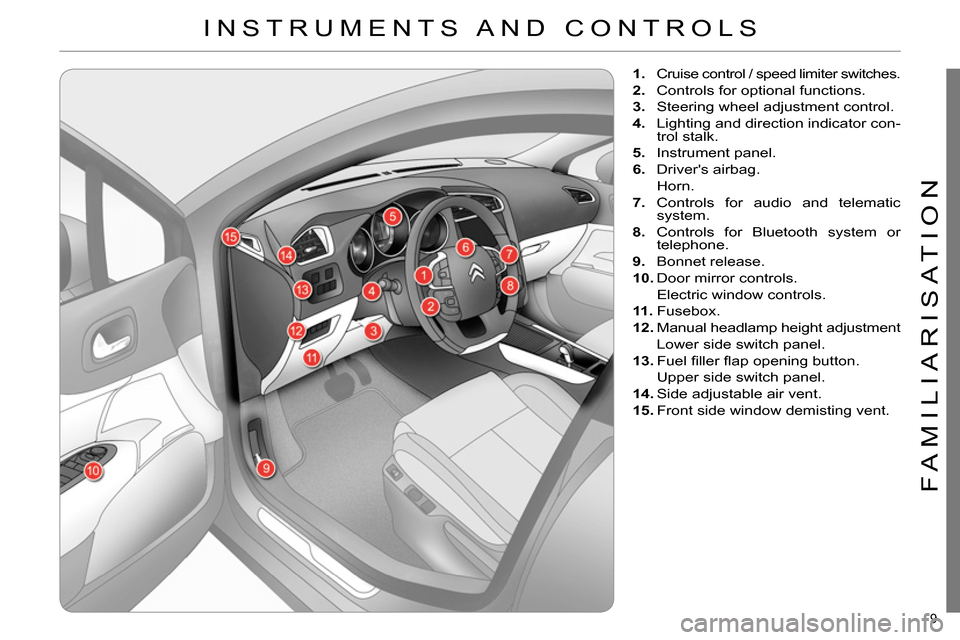
9
FAMILIARISATION
INSTRUMENTS AND CONTROLS
1.
Cruise control / speed limiter switches.
2.
Controls for optional functions.
3.
Steering wheel adjustment control.
4.
Lighting and direction indicator con-
trol stalk.
5.
Instrument panel.
6.
Driver's airbag.
Horn.
7.
Controls for audio and telematic
system.
8.
Controls for Bluetooth system or
telephone.
9.
Bonnet release.
10.
Door mirror controls.
Electric window controls.
11 .
Fusebox.
12.
Manual headlamp height adjustment
Lower side switch panel.
13.
Fuel fi ller fl ap opening button.
Upper side switch panel.
14.
Side adjustable air vent.
15.
Front side window demisting vent.
Page 28 of 340

26
Eco-driving is a range of everyday practices that allow the motorist to optimise their fuel consumption and CO2 emissions.
Optimise the use of your
gearbox
With a manual gearbox, move off gen-
tly and change up without waiting.
During acceleration change up early.
With an automatic or electronic gear-
box, give preference to automatic mode
and avoid pressing the accelerator
pedal heavily or suddenly.
Drive smoothly
Maintain a safe distance between ve-
hicles, use engine braking rather than
the brake pedal, and press the accel-
erator progressively. These practices
contribute towards a reduction in fuel
consumption and CO
2 emissions and
also helps reduce the background traf-
fi c noise.
If your vehicle has cruise control, make
use of the system at speeds above
25 mph (40 km/h) when the traffi c is
fl owing well.
Control the use of your
electrical equipment
Before moving off, if the passenger
compartment is too warm, ventilate it
by opening the windows and air vents
before using the air conditioning.
Above 30 mph (50 km/h), close the
windows and leave the air vents open.
Remember to make use of equipment
that can help keep the temperature
in the passenger compartment down
(sunroof and window blinds...).
Switch off the air conditioning, unless
it has automatic regulation, as soon as
the desired temperature is attained.
Switch off the demisting and defrosting
controls, if not automatic.
Switch off the heated seat as soon as
possible.
ECO-DRIVING
The gear shift indicator invites you to
change up: as soon as the indication
to change up is displayed in the instru-
ment panel, follow it straight away.
With an electronic or automatic gear-
box, this indicator appears only in
manual mode.
Page 57 of 340
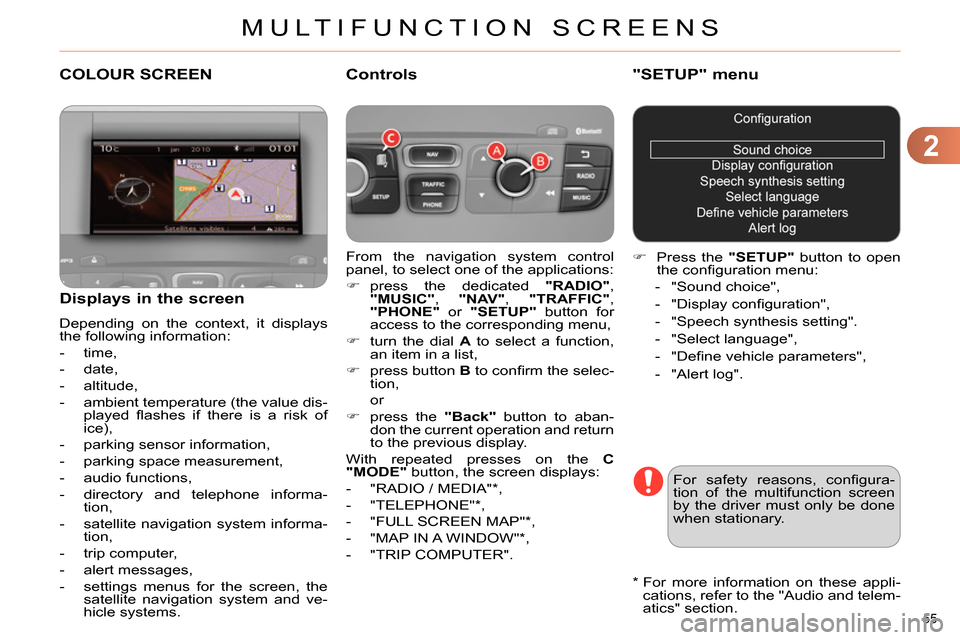
2
MULTIFUNCTION SCREENS
55
COLOUR SCREEN
From the navigation system control
panel, to select one of the applications:
press the dedicated "RADIO"
,
"MUSIC"
, "NAV"
, "TRAFFIC"
,
"PHONE"
or "SETUP"
button for
access to the corresponding menu,
turn the dial A
to select a function,
an item in a list,
press button B
to confi rm the selec-
tion,
or
press the "Back"
button to aban-
don the current operation and return
to the previous display.
With repeated presses on the C
"MODE"
button, the screen displays:
- "RADIO / MEDIA" * ,
- "TELEPHONE" * ,
- "FULL SCREEN MAP" * ,
- "MAP IN A WINDOW" * ,
- "TRIP COMPUTER".
Controls
"SETUP" menu
Press the "SETUP"
button to open
the confi guration menu:
- "Sound choice",
- "Display confi guration",
- "Speech synthesis setting".
- "Select language",
- "Defi ne vehicle parameters",
- "Alert log".
For safety reasons, confi gura-
tion of the multifunction screen
by the driver must only be done
when stationary.
Displays in the screen
Depending on the context, it displays
the following information:
- time,
- date,
- altitude,
- ambient temperature (the value dis-
played fl ashes if there is a risk of
ice),
- parking sensor information,
- parking space measurement,
- audio functions,
- directory and telephone informa-
tion,
- satellite navigation system informa-
tion,
- trip computer,
- alert messages,
- settings menus for the screen, the
satellite navigation system and ve-
hicle systems.
*
For more information on these appli-
cations, refer to the "Audio and telem-
atics" section.
Page 61 of 340

2
MULTIFUNCTION SCREENS
59
Colour screen
Display modes
Information display
Press this button, located on the
end of the wiper stalk
, to display
the following information in turn:
●
current information,
●
trip "1"
,
●
trip "2"
,
- Current information is displayed in
the screen, depending on the con-
text:
●
the range,
●
the current fuel consumption,
●
Stop & Start time counter,
or
●
the remaining distance to go.
Trip zero reset
When the required trip is displayed,
press the button on the end of the
wiper stalk
for more than two sec-
onds.
Trips "1"
and "2"
are independent but
their use is identical.
For example, trip "1"
can be used for
daily fi gures and trip "2"
for monthly
fi gures.
Press the button on the end of the
wiper stalk
to display the trip com-
puter information temporarily in a
new window.
Press the button on the
eMyWay front panel,
to display continuously
the trip computer infor-
mation.
- The trip "1"
screen displays:
●
the distance travelled,
●
the average fuel consumption,
●
the average speed,
for the
fi rst trip.
- The trip "2"
screen displays:
●
the distance travelled,
●
the average fuel consumption,
●
the average speed,
for the second trip.
Page 63 of 340

3
COMFORT
61
VENTILATION
Air intake
The air circulating in the passenger com-
partment is fi ltered and originates either
from the outside via the grille located at
the base of the windscreen or from the
inside in air recirculation mode.
Air treatment
The incoming air follows various routes
depending on the controls selected by
the driver:
- direct arrival in the passenger com-
partment (air intake),
- passage through a heating circuit
(heating),
- passage through a cooling circuit
(air conditioning).
Control panel
The controls of this system are grouped
together on control panel A
on the centre
console.
Air distribution
1.
Windscreen demisting-defrosting vents.
2.
Front side window demisting-defrost-
ing vents.
3.
Side adjustable air vents.
4.
Central adjustable air vents.
5.
Air outlets to the front footwells.
6.
Air nozzles to the front footwells.
7.
Air outlets to the rear footwells.
Page 65 of 340
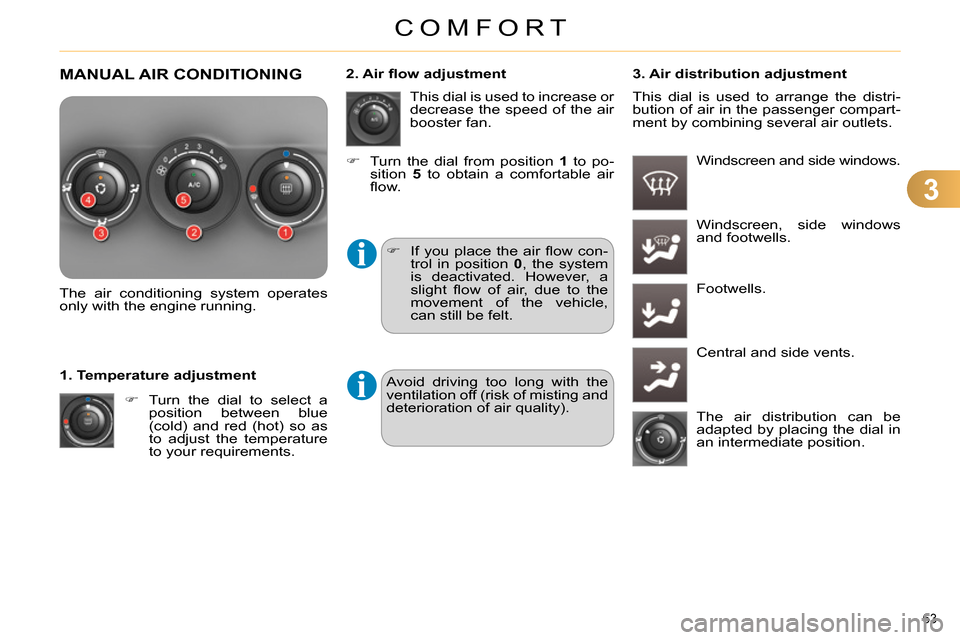
3
COMFORT
63
MANUAL AIR CONDITIONING
The air conditioning system operates
only with the engine running.
Turn the dial to select a
position between blue
(cold) and red (hot) so as
to adjust the temperature
to your requirements.
1. Temperature adjustment This dial is used to increase or
decrease the speed of the air
booster fan.
2. Air fl ow adjustment
3. Air distribution adjustment
Windscreen and side windows.
If you place the air fl ow con-
trol in position 0
, the system
is deactivated. However, a
slight fl ow of air, due to the
movement of the vehicle,
can still be felt.
Windscreen, side windows
and footwells.
Footwells.
Central and side vents.
The air distribution can be
adapted by placing the dial in
an intermediate position.
Turn the dial from position 1
to po-
sition 5
to obtain a comfortable air
fl ow. This dial is used to arrange the distri-
bution of air in the passenger compart-
ment by combining several air outlets.
Avoid driving too long with the
ventilation off (risk of misting and
deterioration of air quality).
Page 66 of 340

3
COMFORT
64
4. Air intake / Air recirculation
The intake of exterior air prevents the
formation of mist on the windscreen
and side windows.
5. Air conditioning On / Off
The air conditioning is de-
signed to operate effectively
in all seasons, with the win-
dows closed.
It enables you to:
- lower the temperature, in summer,
- increase the effectiveness of the
demisting in winter, above 3 °C.
Switching on
Press the "A/C"
button, the button's
indicator lamp comes on.
Switching off
Press the "A/C"
button again, the
button's indicator lamp goes off.
Switching off may affect comfort levels
(humidity, condensation).
The recirculation of interior air isolates
the passenger compartment from exte-
rior odours and smoke.
Press the button to recir-
culate the interior air. The
indicator lamp comes on
to confi rm this.
Press the button again to permit the
intake of exterior air. The indicator
lamp goes off to confi rm this.
This function allows hot or cold
air to be delivered selectively
and more quickly.
Return to exterior air intake as soon as
possible to prevent deterioration of the
the air quality and the formation of mist.
The air conditioning does not
operate when the air fl ow adjust-
ment control 2
is in position " 0
".
To obtain cooled air more quick-
ly, you can use recirculation of
interior air for a few moments.
Then return to fresh air intake.
Page 69 of 340
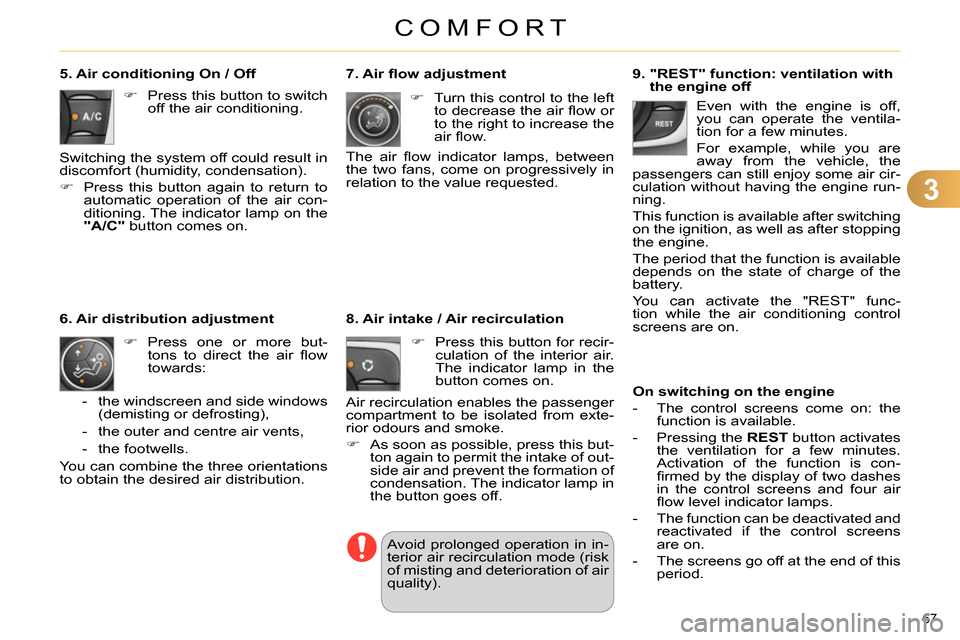
3
COMFORT
67
9. "REST" function: ventilation with
the engine off
On switching on the engine
- The control screens come on: the
function is available.
- Pressing the REST
button activates
the ventilation for a few minutes.
Activation of the function is con-
fi rmed by the display of two dashes
in the control screens and four air
fl ow level indicator lamps.
- The function can be deactivated and
reactivated if the control screens
are on.
- The screens go off at the end of this
period. Even with the engine is off,
you can operate the ventila-
tion for a few minutes.
For example, while you are
away from the vehicle, the
passengers can still enjoy some air cir-
culation without having the engine run-
ning.
This function is available after switching
on the ignition, as well as after stopping
the engine.
The period that the function is available
depends on the state of charge of the
battery.
You can activate the "REST" func-
tion while the air conditioning control
screens are on.
7. Air fl ow adjustment
Turn this control to the left
to decrease the air fl ow or
to the right to increase the
air fl ow.
The air fl ow indicator lamps, between
the two fans, come on progressively in
relation to the value requested.
5. Air conditioning On / Off
Press this button to switch
off the air conditioning.
Switching the system off could result in
discomfort (humidity, condensation).
Press this button again to return to
automatic operation of the air con-
ditioning. The indicator lamp on the
"A/C"
button comes on.
Press one or more but-
tons to direct the air fl ow
towards:
6. Air distribution adjustment
- the windscreen and side windows
(demisting or defrosting),
- the outer and centre air vents,
- the footwells.
You can combine the three orientations
to obtain the desired air distribution.
8. Air intake / Air recirculation
Press this button for recir-
culation of the interior air.
The indicator lamp in the
button comes on.
Air recirculation enables the passenger
compartment to be isolated from exte-
rior odours and smoke.
As soon as possible, press this but-
ton again to permit the intake of out-
side air and prevent the formation of
condensation. The indicator lamp in
the button goes off.
Avoid prolonged operation in in-
terior air recirculation mode (risk
of misting and deterioration of air
quality).